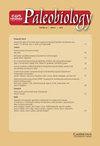The Fezouata Shale Formation biota is typical for the high latitudes of the Early Ordovician—a quantitative approach
IF 2.7
2区 地球科学
Q2 BIODIVERSITY CONSERVATION
引用次数: 0
Abstract
The Fezouata Shale Formation has dramatically impacted our understanding of Early Ordovician marine ecosystems before the great Ordovician biodiversification event (GOBE), thanks to the abundance and quality of exceptionally preserved animals within it. Systematic work has noted that the shelly fossil subassemblages of the Fezouata Shale biota are typical of open-marine deposits from the Lower Ordovician, but no studies have tested the quantitative validity of this statement. We extracted 491 occurrences of recalcitrant fossil genera from the Paleobiology Database to reconstruct 31 subassemblages to explore the paleoecology of the Fezouata Shale and other contemporary, high-latitude (66°S–90°S) deposits from the Lower Ordovician (485.4–470 Ma) and test the interpretation that the Fezouata Shale biota is typical for an Ordovician open-marine environment. Sørensen's dissimilarity metrics and Wilcoxon tests indicate that the subassemblages of the Tremadocian-aged lower Fezouata Shale are approximately 20% more heterogenous than the Floian-aged upper Fezouata Shale. Dissimilarity metrics and visualization suggest that while the lower Fezouata and upper Fezouata share faunal components, the two sections have distinct faunas. We find that the faunal composition of the lower Fezouata Shale is comparable with other Tremadocian-aged subassemblages from high latitudes, suggesting that it is typical for an Early Ordovician open-marine environment. We also find differences in faunal composition between Tremadocian- and Floian-aged deposits. Our results corroborate previous field-based and qualitative systematic studies that concluded that the shelly assemblages of the Fezouata Shale are comparable with those of other Lower Ordovician deposits from high latitudes. This establishes the first quantitative baseline for examining the composition and variability within the assemblages of the Fezouata Shale and will be key to future studies attempting to discern the degree to which it can inform our understanding of marine ecosystems just before the start of the GOBE.费祖阿塔页岩层生物群是早奥陶纪高纬度地区的典型生物群--一种定量方法
由于费祖阿塔页岩层中保存了大量高质量的特殊动物,它极大地影响了我们对奥陶纪生物多样性大事件(GOBE)之前早奥陶世海洋生态系统的了解。有系统的研究指出,费祖阿塔页岩生物群的搁浅化石亚组合是下奥陶纪开放海洋沉积的典型特征,但还没有研究对这一说法的定量有效性进行检验。我们从古生物数据库(Paleobiology Database)中提取了 491 个出现过的难活化石属种,重建了 31 个亚组合,以探索下奥陶世(485.4-470 Ma)费祖阿塔页岩和其他当代高纬度(66°S-90°S)沉积的古生态,并检验费祖阿塔页岩生物群是典型的奥陶世开放海洋环境的解释。索伦森(Sørensen)异质性度量和威尔科克森(Wilcoxon)检验表明,特雷马多克纪年龄的下费祖塔页岩亚组合的异质性比弗洛亚纪年龄的上费祖塔页岩高出约 20%。差异度量和可视化表明,虽然下费祖塔页岩和上费祖塔页岩具有相同的动物成分,但这两个地段的动物群却截然不同。我们发现费祖阿塔页岩下部的动物组成与高纬度地区其他特雷玛多克纪时代的亚组合相似,表明它是典型的早奥陶世开放海洋环境。我们还发现 Tremadocian 时代和 Floian 时代沉积物的动物组成存在差异。我们的研究结果证实了之前基于野外和定性系统研究的结论,即费祖阿塔页岩的搁浅组合与高纬度地区其他下奥陶世沉积物的搁浅组合具有可比性。这为研究费祖阿塔页岩集合体的组成和变异性建立了第一个定量基准,对于今后研究费祖阿塔页岩在多大程度上能够帮助我们了解全球大洋环流开始前的海洋生态系统至关重要。
本文章由计算机程序翻译,如有差异,请以英文原文为准。
求助全文
约1分钟内获得全文
求助全文
来源期刊

Paleobiology
地学-古生物学
CiteScore
5.30
自引率
3.70%
发文量
38
审稿时长
>12 weeks
期刊介绍:
Paleobiology publishes original contributions of any length (but normally 10-50 manuscript pages) dealing with any aspect of biological paleontology. Emphasis is placed on biological or paleobiological processes and patterns, including macroevolution, extinction, diversification, speciation, functional morphology, bio-geography, phylogeny, paleoecology, molecular paleontology, taphonomy, natural selection and patterns of variation, abundance, and distribution in space and time, among others. Taxonomic papers are welcome if they have significant and broad applications. Papers concerning research on recent organisms and systems are appropriate if they are of particular interest to paleontologists. Papers should typically interest readers from more than one specialty. Proposals for symposium volumes should be discussed in advance with the editors.
 求助内容:
求助内容: 应助结果提醒方式:
应助结果提醒方式:


